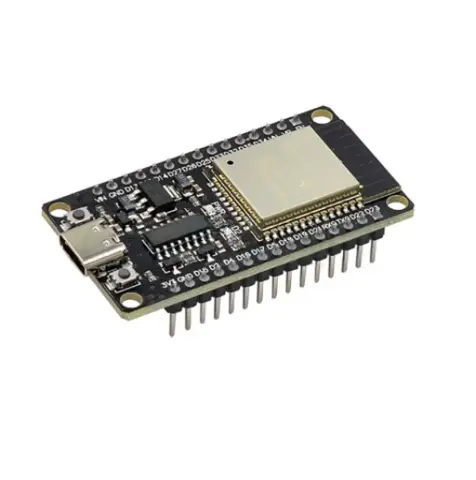Features:
- Dual-core 32-bit microcontroller based on the Xtensa LX6 architecture
- Integrated 802.11 b/g/n WiFi and Bluetooth 4.2 BLE connectivity
- 4MB flash memory for program storage
- Support for several serial communication protocols: UART, I2C, SPI, SDIO
- Integrated USB-to-serial converter (CH340) with USB Type-C connector
- 12-bit ADC for analog input
- Support for PWM output and touch sensors
- Compatible with Arduino IDE, MicroPython, and Lua
- Low power consumption with multiple sleep modes
- Compact and low-cost — ideal for IoT and embedded projects
Principle of Work:
Key components on the board include:
- ESP32 module: Main controller with dual-core processor, WiFi, and Bluetooth.
- CH340 USB-to-serial converter: Used for programming and serial communication via USB Type-C.
- Voltage regulator: Converts input voltage to stable 3.3V.
- LEDs and buttons: For power, status, and reset.
Inside the ESP32 chip:
- Dual-core processor: Handles computation and multitasking.
- WiFi and Bluetooth modules: Provide wireless communication.
- Memory: Includes Flash, SRAM, and optional PSRAM.
- Peripheral interfaces: UART, SPI, I2C, and SDIO.
When powered on, the ESP32 initializes and runs the stored program from flash memory. The program can access sensors, communicate wirelessly, and control outputs through GPIOs.
Pinout of the Module:
Common pin functions:
- 3.3V: Power output for external circuits.
- VIN: Power input (5V–12V).
- GND: Ground.
- GPIO Pins: Configurable digital I/O pins.
- TX/RX: UART communication pins.
- EN: Enable/reset pin.
Features:
- Dual-core 32-bit microcontroller based on the Xtensa LX6 architecture
- Integrated 802.11 b/g/n WiFi and Bluetooth 4.2 BLE connectivity
- 4MB flash memory for program storage
- Support for several serial communication protocols: UART, I2C, SPI, SDIO
- Integrated USB-to-serial converter (CH340) with USB Type-C connector
- 12-bit ADC for analog input
- Support for PWM output and touch sensors
- Compatible with Arduino IDE, MicroPython, and Lua
- Low power consumption with multiple sleep modes
- Compact and low-cost — ideal for IoT and embedded projects
Principle of Work:
Key components on the board include:
- ESP32 module: Main controller with dual-core processor, WiFi, and Bluetooth.
- CH340 USB-to-serial converter: Used for programming and serial communication via USB Type-C.
- Voltage regulator: Converts input voltage to stable 3.3V.
- LEDs and buttons: For power, status, and reset.
Inside the ESP32 chip:
- Dual-core processor: Handles computation and multitasking.
- WiFi and Bluetooth modules: Provide wireless communication.
- Memory: Includes Flash, SRAM, and optional PSRAM.
- Peripheral interfaces: UART, SPI, I2C, and SDIO.
When powered on, the ESP32 initializes and runs the stored program from flash memory. The program can access sensors, communicate wirelessly, and control outputs through GPIOs.
Pinout of the Module:
Common pin functions:
- 3.3V: Power output for external circuits.
- VIN: Power input (5V–12V).
- GND: Ground.
- GPIO Pins: Configurable digital I/O pins.
- TX/RX: UART communication pins.
- EN: Enable/reset pin.
